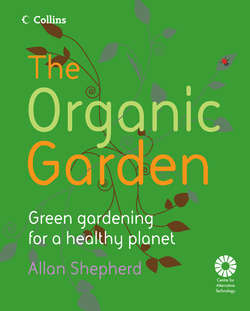Читать книгу The Organic Garden - Allan Shepherd - Страница 45
Why ‘shed’s dead’?
ОглавлениеApart from wanting to reference Bruce Willis’s performance in Pulp Fiction, why have I called this section Shed’s Dead? After all, a shed is a wonderful thing – probably the closest thing gardeners have to a cultural icon. It’s a triumph of simplicity and efficiency, combining as it does several important gardening functions within its four thin walls. Being a simple, effective place to store tools is probably the least important job it does. Most non-gardeners wonder what the allure of the shed can be: it’s such a drab, soulless-looking place from the outside. Step inside, however. and you’re immediately in another world. A place where a deckchair, a bottle of wine or a flask of tea is always close by. Where a wind-up radio can be kept wound and primed for a Sunday afternoon of Gardeners’ Question Time on Radio Four. Where the world and its wife can just go and play somewhere else, quite frankly.
I don’t just want a shed, I want a home office with a wood stove and a place to sling a hammock if I feel like sleeping over.
So why would I wish the shed dead? Well, I think we can do better. The first clue came midway through the last paragraph. Why are sheds so drab and soulless? Look at any of the seemingly endless number of shed websites and you will see the same bland carboncopy boxes coming up again and again. They don’t give any clue to the personality of the owner. They don’t blend in with a garden. They don’t add anything apart from convenience to a space. No character. No inspiration. No sense of imagination. A shed is a thing to be hidden by plants, to be shoved into the corners of a garden, to be rendered invisible if possible. Or in the worst gardens, just placed without any thought whatsoever so it sticks out like a tower block amongst tiny rows of terraced-house vegetables. A towering example of mass-produced modernity.
All this could be forgiven if sheds met high environmental criteria, but unless you buy an FSC-approved shed you don’t really know what you’re getting. Buying the average shed is a journey into the unknown. Imagine you’ve just created your beautiful eco-friendly garden. Everything’s carefully laid out to be pleasing to the eye and the soul. And now you need some storage. Well, the average shed is just not doing it for me.
The company Forest Garden supplies DIY shops and garden centres with wood products for the garden, including sheds, using timber cut from FSC-approved UK forests owned by the Forestry Commission. Look out for their label and visit www.forestgarden.co.uk/stockists.asp for the nearest place to buy. Also try www.grange-fencing.com for timber sheds and summerhouses. B&Q and Focus both sell FSC-approved sheds. Try www.greatlittlegarden.co.uk for a range of European-grown FSCapproved timber products, as well as www.simply-summerhouses.co.uk. There are now a number of recycled plastic sheds on the market. Look at: www.langhalegardens.co.uk, www.hudsonwright.net/plastic-storage-sheds.htm, www.heskethsplastics.com/recycled.htm.
What I haven’t said yet is that I don’t just want a shed, I want a home office with a wood stove and a place to sling a hammock if I feel like sleeping over. My shed will have star-gazing windows and a balcony. A hot plate for making tea and a little mouse-proof store for provisions. I imagine my shed will be a little like old Ratty’s house in Wind in the Willows, only with a loftier view. Occasionally I’ll get a visit from Mole and we’ll take a picnic down to the lawn. Nasturtium flowers will hang down from small wooden pots and I shall graze on the peppery leaves. From the balcony I will be able to survey the weed situation in the whole of my garden with a small spyglass, like a sailor looking out to sea for a sight of the enemy. It’s a fantasy, but, if you haven’t got a dream, how you gonna have a dream come true?
I started having my shed fantasy way back at Robert Plant’s place when my friend Kevin Beale built one of Britain’s first straw bale buildings: a garden shelter constructed with bales, reclaimed timber, secondhand pallets and lime render (an eco finishing material). It’s the first time I’d ever watched a craftsman at work. Building was a logical step-by-step process. But it was also an art form. The shed was finished off with sculptured lizards climbing down the corners towards the soil. It gave me a privileged close-up view of the art of making something out of nothing. Shed Zeppelin was a fairly bulky number – never use straw bales in a tight squeeze – and it lacked the finesse other materials would have allowed, but it was made on next-to-no budget and worked. It’s still there on Robert’s farm, even though the rest of the garden has sadly passed up the stairway to heaven to that great allotment in the sky.
